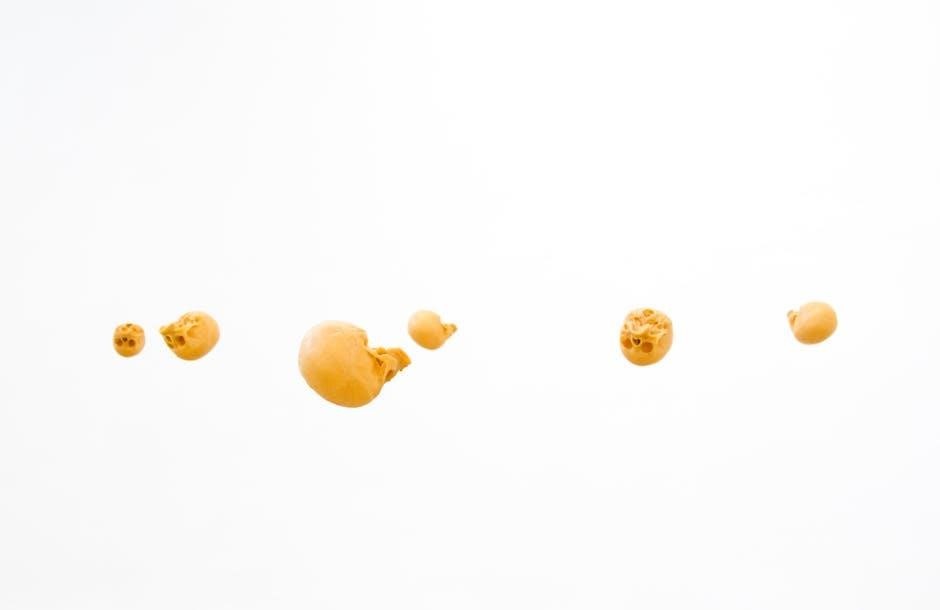The zero bone loss concept, introduced by Dr. Tomas Linkevičius, emphasizes maintaining crestal bone stability around dental implants for long-term aesthetic and functional success. This approach combines biological principles and modern implant designs to prevent bone resorption, ensuring predictable outcomes and patient satisfaction. It addresses a critical challenge in implantology, offering clinicians a structured methodology to achieve optimal results.
1.1 Overview of Bone Loss in Implantology
Bone loss in implantology remains a significant challenge, often leading to aesthetic and functional complications. It occurs due to various biological and mechanical factors, including surgical trauma, prosthetic overload, and inflammatory processes. Crestal bone resorption is particularly concerning, as it can compromise implant stability and affect long-term outcomes. Understanding the etiology of bone loss is crucial for developing strategies to mitigate it. The zero bone loss concept aims to address this issue by emphasizing crestal bone stability, a key factor in achieving predictable results and patient satisfaction. By addressing bone loss prevention, clinicians can enhance the durability and success of dental implants, ultimately improving both aesthetic and functional outcomes for patients.
1.2 Significance of the Zero Bone Loss Concept
The zero bone loss concept holds paramount importance in modern implantology, as it directly impacts the long-term success and aesthetics of dental implants. By prioritizing crestal bone stability, this concept minimizes the risk of bone resorption, ensuring implants remain stable and functional over time. Clinicians benefit from enhanced predictability and patient satisfaction, while patients gain improved oral health and confidence. This approach also reduces the need for additional procedures, such as bone grafting, making it a cost-effective and efficient solution. The concept aligns with current trends in implantology, emphasizing both biological and mechanical harmony to achieve optimal outcomes. Its significance lies in its ability to address a critical challenge in the field, offering a pathway to more successful and sustainable implant treatments.

Definition and Importance
The zero bone loss concept, introduced by Dr. Tomas Linkevičius, focuses on minimizing crestal bone resorption around implants, ensuring long-term stability and aesthetics, which are critical for functional success and patient satisfaction.
2.1 Defining Zero Bone Loss
Zero bone loss refers to the preservation of the crestal bone level around dental implants, ensuring no significant resorption occurs post-surgery or during healing. This concept, introduced by Dr. Tomas Linkevičius, aims to achieve stability and aesthetics by maintaining the bone-implant interface. It involves precise surgical techniques, such as subcrestal implant placement and bone flattening, to prevent bone remodeling. The goal is to minimize any changes in the bone structure, ensuring a stable foundation for the implant. This definition underscores the importance of biological compatibility and mechanical stability, crucial for long-term implant success and patient satisfaction.
2.2 Importance in Dental Implantology
The zero bone loss concept is crucial in dental implantology as it directly impacts the long-term success and aesthetics of implant treatments. Maintaining crestal bone stability prevents bone resorption, which can lead to aesthetic and functional complications. This approach ensures the preservation of the natural contour of the jawbone, reducing the risk of peri-implantitis and other complications. A stable bone-implant interface enhances the patient’s quality of life by restoring chewing function and confidence. Clinicians benefit from predictable outcomes, reduced revision surgeries, and improved patient satisfaction. By addressing bone loss early, the concept promotes durable results, making it a cornerstone of modern implantology. Its importance lies in combining biological and mechanical principles to achieve optimal, long-lasting implant success.

Biological and Anatomical Considerations
Bone remodeling and soft tissue thickness play pivotal roles in maintaining crestal bone stability. Understanding these biological and anatomical factors is essential for achieving zero bone loss.
3.1 Bone Biology and Remodeling
Bone remodeling is a continuous process involving osteoclast-mediated resorption and osteoblast-driven formation. In the context of dental implants, this balance is crucial for maintaining crestal bone stability. The zero bone loss concept hinges on understanding how mechanical stress, biological responses, and anatomical factors influence this process. Proper implant design and placement can minimize adverse remodeling, while soft tissue thickness acts as a protective barrier. Achieving harmony between bone biology and implantology ensures long-term stability and aesthetic outcomes, making bone remodeling a cornerstone of successful implant treatment.
3.2 Role of Soft Tissue Thickness
Soft tissue thickness plays a pivotal role in achieving and maintaining zero bone loss. Thicker soft tissues act as a protective barrier against mechanical and biological stressors, reducing the likelihood of crestal bone resorption. They also facilitate even load distribution during implant placement and functional loading. The concept emphasizes that adequate soft tissue thickness is essential for long-term stability and aesthetic outcomes. Vertical soft tissue augmentation techniques are often employed to enhance these protective qualities, ensuring a harmonious relationship between the implant and surrounding tissues. This biological synergy is critical for preventing bone loss and achieving predictable results in implantology.

Surgical Techniques for Zero Bone Loss
Subcrestal implant placement, bone flattening, and vertical soft tissue augmentation are key techniques to minimize bone resorption and ensure long-term crestal bone stability around implants.
4.1 Subcrestal Implant Placement
Subcrestal implant placement involves positioning the implant slightly below the alveolar crest to minimize bone resorption and prevent the “tent-pole” effect. This technique ensures even stress distribution, preserving crestal bone levels and promoting long-term stability. By placing the implant apically, it reduces the likelihood of marginal bone loss, enhancing both aesthetic and functional outcomes. Proper surgical execution is critical to avoid complications and ensure the implant integrates successfully with the surrounding bone and soft tissue.
4.2 Bone Flattening Techniques
Bone flattening techniques are essential for achieving zero bone loss by creating a stable platform for implant placement. This method involves shaping the alveolar crest to eliminate uneven surfaces, ensuring even stress distribution and preventing focal stress points. The tent-pole technique, a variation of bone flattening, uses a thin layer of bone or grafting material to support the implant crestally. This approach minimizes bone resorption and maintains marginal bone levels. Proper execution requires precise surgical planning and execution to avoid over-flattening, which could compromise implant stability. Bone flattening is often combined with subcrestal implant placement to optimize aesthetic and functional outcomes, ensuring long-term crestal bone stability and implant success. This technique is particularly beneficial in cases with limited bone availability or challenging anatomical conditions.
4.3 Vertical Soft Tissue Augmentation
Vertical soft tissue augmentation is a critical procedure in achieving the zero bone loss concept, focusing on enhancing the thickness and stability of the peri-implant soft tissues. This technique is particularly useful in cases with insufficient soft tissue volume, which can compromise both aesthetics and function. By increasing the vertical dimension of the soft tissue, clinicians can create a more stable environment around the implant, reducing the risk of bone resorption and ensuring long-term tissue health. Various methods, such as connective tissue grafts or the use of biomaterials, are employed to achieve this augmentation. Properly executed vertical soft tissue augmentation not only improves implant aesthetics but also minimizes the risk of complications, such as tissue recession or implant exposure, ultimately contributing to a more predictable and successful outcome;

Maintaining Crestal Bone Stability
Maintaining crestal bone stability requires precise implant design, controlled loading protocols, and biological harmony, ensuring long-term aesthetic and functional success in dental implantology and patient satisfaction.
5.1 Prosthetic Considerations
Prosthetic considerations play a pivotal role in maintaining crestal bone stability. Proper design and fit of the prosthesis ensure even distribution of occlusal forces, preventing excessive stress on the bone-implant interface. Selection of appropriate abutments and restorative materials is critical to avoid micromovement, which can lead to bone resorption. Additionally, the prosthetic design should harmonize with the patient’s oral anatomy, ensuring optimal aesthetics and function. Digital workflows and CAD/CAM technologies are increasingly utilized to achieve precise fit and minimize mechanical complications. Regular monitoring of the prosthetic components and adjustments as needed further contribute to long-term stability and success of the implant. These considerations collectively support the zero bone loss concept by safeguarding the crestal bone health.
5.2 Loading Protocols
Loading protocols are critical in achieving and maintaining crestal bone stability. Immediate loading, when performed with adequate primary stability, can preserve bone levels and promote osseointegration. A torque of 30-40 Ncm is often recommended for immediate loading to ensure implant stability. Provisional restorations with reduced occlusal contacts are used to avoid excessive stress during the initial healing phase. Gradual loading protocols, where implants are loaded incrementally, may be preferred in challenging cases or low-density bone to minimize stress and promote bone remodeling. Properly designed loading protocols, tailored to patient-specific factors, are essential for long-term success and adherence to the zero bone loss concept. These strategies ensure that functional forces are distributed optimally, preserving the marginal bone and supporting implant longevity.
5.3 Long-Term Maintenance Strategies
Long-term maintenance is crucial for preserving crestal bone stability and ensuring implant longevity. Regular follow-ups, including radiographic evaluations, are essential to monitor bone levels and soft tissue health. Personalized oral hygiene regimens, such as interdental brushing and antimicrobial rinses, are tailored to prevent biofilm accumulation. Professional cleanings, like implant-specific prophylaxis, are recommended to remove plaque and tartar, reducing inflammation. Digital tools, such as CBCT scans, aid in monitoring bone density and soft tissue thickness. Occlusal adjustments are performed to distribute forces evenly, minimizing stress on implants. Patient education is vital to ensure adherence to maintenance routines. These strategies collectively support the zero bone loss concept, fostering a stable and functional implant environment for years post-placement.


Soft Tissue Management
Soft tissue management is critical for achieving and maintaining crestal bone stability; Adequate soft tissue thickness and health are essential for long-term implant success and aesthetics.
6.1 Techniques for Soft Tissue Augmentation
Soft tissue augmentation is a cornerstone in achieving long-term implant success. Vertical soft tissue augmentation enhances the thickness and quality of the peri-implant mucosa, ensuring adequate biological width. Techniques such as the tent-pole method and connective tissue grafts are commonly employed to increase soft tissue volume. These procedures not only improve aesthetics but also contribute to crestal bone stability. Proper surgical execution and patient selection are critical for predictable outcomes. The goal is to create a harmonious balance between soft tissue health and bone preservation, aligning with the zero bone loss concept. Advanced methods, including envelope flap procedures, further optimize soft tissue architecture, ensuring durability and natural appearance.
6.2 Importance of Tissue Architecture
Tissue architecture plays a pivotal role in achieving and maintaining crestal bone stability, a cornerstone of the zero bone loss concept. Properly designed tissue contours ensure optimal load distribution, minimizing the risk of bone resorption. Aesthetic and functional outcomes are significantly enhanced when soft tissue thickness and architecture align with implant placement. The harmony between biological and mechanical factors underscores the importance of precise tissue management. Maintaining adequate soft tissue thickness not only supports bone health but also contributes to the long-term success and natural appearance of dental implants. Thus, attention to tissue architecture is essential for predictable and sustainable results in implantology.

Case Studies and Clinical Evidence
Case studies demonstrate the zero bone loss concept’s effectiveness, showcasing successful implant placements and long-term crestal bone stability. Clinical evidence validates its reliability and aesthetic outcomes.
7.1 Successful Implant Cases
Documented cases highlight the success of the zero bone loss concept in achieving stable crestal bone levels. A notable case involved a patient with a history of periodontal disease, where subcrestal implant placement and bone flattening techniques resulted in minimal bone resorption over five years. Another case demonstrated the effectiveness of vertical soft tissue augmentation, ensuring optimal aesthetics and functionality. These examples underscore the concept’s reliability in challenging anatomical conditions. Clinical outcomes consistently show maintained marginal bone stability, supporting the long-term success of implants. Such cases provide valuable insights for clinicians, reinforcing the importance of precise surgical techniques and patient-specific strategies. The integration of biological principles and advanced methods ensures predictable results, making the zero bone loss concept a cornerstone in modern implantology.
7.2 Lessons from Clinical Outcomes
Clinical outcomes from zero bone loss cases reveal critical insights into achieving long-term implant success. A key lesson is the importance of crestal bone stability, which directly influences both aesthetic and functional results. Loading protocols and prosthetic designs must be tailored to individual patient anatomy to minimize stress on the bone-implant interface. Additionally, soft tissue thickness plays a pivotal role in maintaining marginal bone levels, emphasizing the need for precise surgical techniques. Long-term maintenance strategies, including regular monitoring and hygiene, are essential to sustain bone stability. These findings underscore the importance of combining biological principles with advanced surgical methods to optimize outcomes. By analyzing clinical results, clinicians can refine their approaches, ensuring predictable and successful implant placements.

Future Trends and Advancements
Emerging technologies in implantology are expected to enhance the zero bone loss concept, with advancements in biocompatible materials and 3D printing leading to more predictable outcomes.
8.1 Emerging Technologies
Emerging technologies are revolutionizing the zero bone loss concept, with advancements in 3D printing and biocompatible materials leading to customized implants that promote bone preservation; Digital workflows enable precise implant placement, minimizing bone trauma and enhancing osseointegration. Innovations in surface modifications and nanostructured implants further improve bone-implant interfaces, reducing the risk of resorption. Additionally, advancements in prosthetic design and loading protocols are being integrated to maintain crestal bone stability. These technological developments are expected to make the zero bone loss concept more accessible and predictable, ensuring long-term aesthetic and functional success in implantology. The integration of artificial intelligence and machine learning may also play a role in optimizing treatment planning and outcomes.

8.2 Research Directions
Research into the zero bone loss concept is advancing rapidly, with a focus on enhancing bone preservation techniques. Studies are exploring bioactive coatings and surface modifications to improve implant osseointegration. Additionally, investigations into 3D-printed bone scaffolds and regenerative materials aim to promote natural bone healing. Soft tissue engineering and biomolecular therapies are also being studied to enhance peri-implant tissue stability. Furthermore, the role of digital technologies, such as AI-driven simulations, is being examined to optimize implant placement and predict long-term outcomes. These research directions aim to refine existing protocols and develop innovative solutions, ensuring the zero bone loss concept remains at the forefront of implantology. Clinical validation of these advancements will be critical to their widespread adoption.
The zero bone loss concept represents a significant advancement in dental implantology, offering a comprehensive approach to achieving long-term crestal bone stability. By combining surgical precision, biomaterial innovation, and meticulous patient care, this concept minimizes bone resorption and enhances aesthetic and functional outcomes. Clinical evidence and case studies underscore its effectiveness, while ongoing research promises further refinements. As implantology evolves, the zero bone loss concept remains a cornerstone for clinicians aiming to deliver predictable, sustainable results. Its adoption not only benefits patients but also elevates the standard of care in the field, ensuring implant dentistry continues to advance toward optimal success rates and patient satisfaction.
